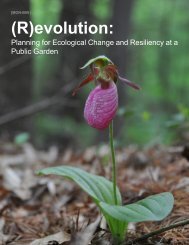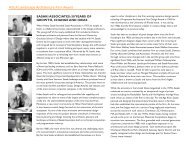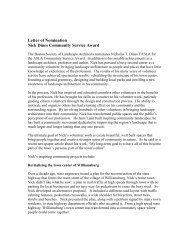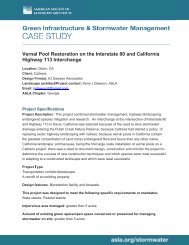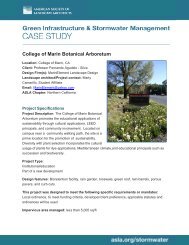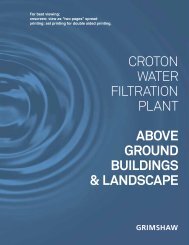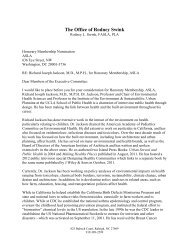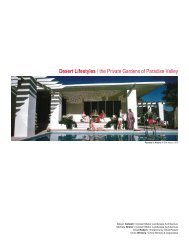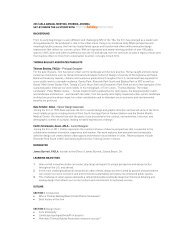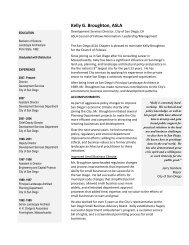In Praise of Noble Trees ASLA Lecture September 12-13, 2010
In Praise of Noble Trees ASLA Lecture September 12-13, 2010
In Praise of Noble Trees ASLA Lecture September 12-13, 2010
You also want an ePaper? Increase the reach of your titles
YUMPU automatically turns print PDFs into web optimized ePapers that Google loves.
<strong>In</strong> <strong>Praise</strong> <strong>of</strong> <strong>Noble</strong> <strong>Trees</strong><br />
<strong>ASLA</strong> <strong>Lecture</strong><br />
<strong>September</strong> <strong>12</strong>-<strong>13</strong>, <strong>2010</strong><br />
Michael A. Dirr, Ph.D.<br />
Great honor to present this lecture (chat) to the American Society <strong>of</strong> Landscape<br />
Architects. Many reasons for praising and planting <strong>Noble</strong> <strong>Trees</strong> include aesthetics, CO2<br />
sequestration, particulate matter interception, shade (cooling), ad infinitum. Recently<br />
learned that in Minneapolis-St. Paul, large elms (American) represent one percent <strong>of</strong><br />
tree population yet capture 30% <strong>of</strong> storm water. Reason: leaf surface area, trunk, and<br />
root system distribution.<br />
How do new tree introductions arise? Testing and evaluation leading to introduction:<br />
how much?; how little? Propagation and production criteria. Marketing. Does the<br />
general public care or understand the value <strong>of</strong> <strong>Noble</strong> <strong>Trees</strong>? Hopefully the handout will<br />
inspire the audience to consider several new trees.<br />
Too many red maples…and still coming, with Redpointe® (‘Frank Jr.’) from J. Frank<br />
Schmidt & Son, among the best <strong>of</strong> the new. Currently, Schmidt’s was evaluating ~ 150<br />
Acer rubrum selections. Where to turn for new selections within the widely adaptable<br />
urban tree genera? Ash sales are down 90 to 95% because <strong>of</strong> emerald ash borer. The<br />
people <strong>of</strong> Michigan and the upper Midwest are too familiar with this biological<br />
devastation. Little to no resistance resides in Fraxinus. Bradford pear and similar ilk are<br />
proving to be invasive, particularly in the South. Norway maple sales are crashing<br />
because <strong>of</strong> invasive issues. Amazingly, elms are on the rebound. Great need to develop<br />
superior cultivars within the palette <strong>of</strong> North American trees. I work closely with J. Frank<br />
Schmidt & Son Nursery, Boring, OR with new introductions. During the Farwest Show<br />
(August), I spend time with Keith Warren, horticulturist, and we discuss the future <strong>of</strong> US<br />
tree breeding and introduction.<br />
Great new (2009) book on tree species introductions over the past 20 years by<br />
Grimshaw and Bayton. See www.kew.org.uk or www.rhs.org.uk for information. Title is<br />
New <strong>Trees</strong>: Recent <strong>In</strong>troductions to Cultivation. Outstanding descriptions, botanical and<br />
horticultural, <strong>of</strong>ten with accompanying photographs, <strong>of</strong> little-known species that to my<br />
way <strong>of</strong> thinking and observing have great landscape merit. New edition <strong>of</strong> The Manual<br />
<strong>of</strong> Woody Landscape Plants (2009) treats most <strong>of</strong> the new cultivar introductions since<br />
1998.<br />
The following represent some <strong>of</strong> the new tree introductions:<br />
Acer―Maple<br />
Need smaller versions for red and sugar; I see Autumn Blaze® falling apart;<br />
Redpointe® is 75% red maple: 25% silver maple with excellent red fall color and<br />
heat tolerance; ‘Sun Valley’ (‘Brandywine’ and ‘Somerset’ are the others) has<br />
1
een the best <strong>of</strong> Dr. Townsend’s seedless introductions; October Glory® and<br />
Red Sunset® are two <strong>of</strong> the most popular red maple cultivars but both have<br />
minor Achilles Heels; Autumn Flame® based on 30 years <strong>of</strong> Dirr evaluation<br />
continues to impress for red fall color, seedless nature, strong branch structure;<br />
new hybrid, Crimson Sunset (‘JFS-KW202’), between ‘Crimson King’ and Acer<br />
truncatum with lustrous red-purple foliage, smaller stature and heat tolerance;<br />
have watched Morton Arboretum’s A. miyabei State Street® (‘Morton’) perform<br />
well in Chicago, Louisville, St. Louis, and Spartanburg, SC. Rugged Ridge is a<br />
new cork-bark A. miyabei from Schmidt; Acer truncatum Main Street (‘WFAT-<br />
1’) with oval-rounded outline, dense branching and magnificent orange-red fall<br />
color. Selected from seedling population in North Carolina by Mike Worthington. I<br />
spied upright and red fall colored Acer saccharum in Georgia that may have a<br />
future. Both display remarkable heat and drought tolerance. Schmidt’s<br />
Flashfire (‘JFS-Caddo-2’), a Caddo type, develops outstanding red fall color<br />
and superior heat tolerance. New upright selections <strong>of</strong> A. rubrum from Schmidt<br />
are close to release. Superior to ‘Armstrong’, ‘Bowhall’, ‘Columnare’, et al. Acer<br />
henryi ( A. cissifolium subsp. henryi) <strong>of</strong>fers red-purple new growth, small stature<br />
(20 to 30’), heat (Georgia), and cold (-24°F) tolerance. A selection is close to<br />
release from Schmidt’s. A sleeper in the wide world <strong>of</strong> maples. Northern Glow<br />
(‘Hasselkus’), a new (introduced <strong>2010</strong>) hybrid <strong>of</strong> Acer pseudosieboldianum and<br />
A. palmatum with increased cold tolerance from Schmidt’s. Also, Landscape<br />
Plant Development Center has many colorful foliage (yellow, red-purple) hybrids<br />
<strong>of</strong> these two parental types. An unsung tree introducer is Dr. Dale Herman, North<br />
Dakota State University, who has selected many trees for cold and drought<br />
tolerances for the plains states. His <strong>2010</strong> sugar maple introduction is Northern<br />
Flare (‘Sisseton’). From Bailey Nursery comes Acer ×freemanii Matador<br />
(‘Bailston’), a <strong>2010</strong> introduction.<br />
Betula lenta subsp. uber—Virginia Roundleaf Birch<br />
A genuine worthy addition to the world <strong>of</strong> garden birches. Found in a restricted<br />
area in southwest Virginia this taxon has received minimal interest from<br />
horticulturists and nursery producers. Small two-inch diameter rounded shiny<br />
dark green leaves turn glowing yellow-gold in autumn. Habit is loosely pyramidal<br />
with gracefully arching secondary branches. From my observations, this taxon is<br />
both cold and heat tolerant. <strong>Trees</strong> grow in Chicago, Boston and Athens, Georgia<br />
with equal facility. National Champion is 45 feet by 15 feet. The broken stems<br />
have the distinct wintergreen odor. Definitely worth considering where white bark<br />
birches have no chance <strong>of</strong> survival.<br />
Betula nigra―River Birch<br />
Resistant to borer, wide adaptability; Heritage® (‘Cully’) was first, then Dura<br />
Heat® (‘BNMTF’), now City Slicker® (‘Whit XXV’) (more heat tolerant) and<br />
Northern Tribute (‘Dickinson’) from Bailey (via Dr. Dale Herman) with Zone 3<br />
hardiness. Worth noting that in Maine, B. nigra is the most commonly planted<br />
birch in new landscapes, superseding even the native B. papyrifera. The<br />
Rennaissance B. papyrifera collection, Compact (‘Cenci’), Oasis® (‘Oenci’),<br />
2
Reflection® (‘Renci’) and Upright (‘Uenci’), appears worthy. Also have been<br />
impressed with Dr. Dale Herman’s Dakota Pinnacle® (‘Fargo’), a 10-year-old tree<br />
was 30’ high, 8.5’ wide, uniform tight pyramidal habit with good borer resistance.<br />
Prairie Vision® (‘VerDale’) from same introducer is semi-pyramidal, widening with<br />
age.<br />
Carpinus betulus―European Hornbeam<br />
Several new heat tolerant selections with habits <strong>of</strong> Tilia cordata; have observed<br />
in nursery production and they carry the Wow factor as young trees. The Schmidt<br />
introduction was probably collected in Turkey. Originally listed as C. cordata but<br />
certainly a C. betulus type. <strong>In</strong>troduced in <strong>2010</strong> as Emerald Avenue (‘JFS-<br />
KW6’). Uniform pyramidal habit, dark green leaves and yellow fall color.<br />
Carpinus caroliniana―American Hornbeam<br />
Wonderful native from Nova Scotia to Florida with Palisade (‘CCSQU’), an<br />
upright form; at least two new red-fall-coloring selections from Michael Yanney,<br />
Wisconsin and Schmidt Nursery. Ball O’Fire (‘J.N. Globe’) is a dense globe 6’<br />
by 5 ½’ after 11 years; Firespire (‘J.N. Upright’) is narrow in outline, 7’ by 3 ½’<br />
after 10 years, with outstanding orange-red fall color. These growth rates are<br />
based on Wisconsin conditions. Native Flame (‘JFS-KW6’) has a habit like<br />
species, dark green summer leaves and red fall color.<br />
Cercidiphyllum japonicum―Katsura<br />
A Dirr favorite. Better adapted to Zone 4 to 6 but grows in 7. Requires moisture<br />
to perform up to its genetic capabilities. Beautiful blue-green leaves turn yellow-<br />
apricot-orange in fall. ‘Rotfuchs’ (‘Red Fox’) produces red-purple, more frost<br />
resistant leaves, losing color in heat. Three weeping forms: ‘Amazing Grace’,<br />
‘Morioka Weeping’ and ‘Tidal Wave’; all are males. ‘Morioka Weeping’ is more<br />
tree-like in stature.<br />
Cercis canadensis―Redbud<br />
Remarkable breeding by Dr. Denny Werner, NCSU, for exciting foliage and habit<br />
traits. ‘Ruby Falls’ is a hybrid between Lavender Twist x ‘Forest Pansy’ with<br />
purple leaves and weeping habit. ‘Hearts <strong>of</strong> Gold’ was the first yellow foliage<br />
introduction; now have The Rising Sun with orange-yellow foliage as well as<br />
‘High Country Gold’, ‘Melon Beauty’ and ‘Solar Eclipse’. ‘Solar Eclipse’ has a<br />
yellow-gold center and one-inch wide green margins. Cold hardy introductions<br />
include ‘Columbus’, Joy’s Pride (‘Morton’), ‘Northland Strain’, and ‘Royal White’<br />
(most cold hardy white-flowered form). ‘Cascading Hearts’ is a weeper with<br />
denser foliage than Lavender Twist. ‘Pink Heartbreaker’ is a strong-growing<br />
weeping form with pink flowers being introduced in <strong>2010</strong>. A new (<strong>2010</strong>) whiteflowered<br />
weeping selection is close to introduction.<br />
Corylus fargesii―Farges Filbert<br />
Small tree with River Birch-like exfoliating bark; supposedly 70’ in wild; largest I<br />
have observed was ~20’ at Arnold Arboretum (2007); growing in Chapel Hill, NC.<br />
3
Recent (Aug, 2009) visit to Longwood Gardens Nursery area provided glimpses<br />
<strong>of</strong> two, ~20’ high magnificent specimens with bark sheathing in salmon-cream<br />
papery sheets. Foliage clean. Unless I am missing some serious pests, this<br />
species, with selection, could be a major contributor to gardens and perhaps<br />
more difficult urban sites. Grows in Morton Arboretum, Lisle, Illinois, Zone (4)5.<br />
Was given a small tree by Mark Krautmann, Heritage Seedlings, Salem, OR.<br />
Fagus grandifolia―American Beech<br />
Maine to Minnesota to Florida native; why not more widely utilized? Reputation<br />
as difficult to transplant; not true as I have never lost one in all my consulting<br />
work; <strong>of</strong>ten difficult to locate in commerce; one <strong>of</strong> America’s most <strong>Noble</strong> trees.<br />
Recently, collected scion-wood from a pyramidal-columnar-form with uniform<br />
upright branching. Schmidt’s will produce.<br />
Ginkgo biloba―Ginkgo<br />
200 million years (?) and still going strong; over 50 cultivars, many oddities;<br />
Presidential Gold (‘The President’) and Golden Colonnade (‘JFS-UGA2’) are<br />
two introductions from my program and are available from Schmidt’s. The former<br />
more spreading; latter columnar-upright. Keith Warren said Presidential Gold<br />
was one <strong>of</strong> the best Ginkgo selections because <strong>of</strong> the full canopy at a young age.<br />
Gymnocladus dioicus―Kentucky C<strong>of</strong>feetree<br />
Zone 4 to 7 adaptability, i.e., Minnesota to Atlanta, and performing well;<br />
extremely variable,need additional selections; have several male clones like<br />
Espresso (‘Espresso-JFS’), Prairie Titan® (‘J.C. McDaniel’), and ‘Stately<br />
Manor’; the latter appears to be the best. Excellent performance at Milliken<br />
Arboretum, Spartanburg, SC, over the past 15-18 years; Also several trees on<br />
the Georgia campus are doing well. Not the easiest tree to propagate by<br />
grafting/budding. Also appears gangly in youth but matures into a handsome<br />
Prince. Bark is beautiful and provides great winter effect. Performs well in<br />
alkaline soils and recent discussion with Wayne Holland, nursery owner<br />
Lubbock,Texas, corroborated its adaptability to the high plains <strong>of</strong> Texas.<br />
Liriodentron tulipifera―Tuliptree<br />
Grows almost too fast! Refrain I hear from nursery producers. Growing<br />
successfully in Minnesota Landscape Arboetum (-30°F). Washington and<br />
Jefferson’s favorite trees. One planted in 1795 is extant at Mt. Vernon. A 9-foot-<br />
diameter tree was removed from Monticello (2008). ‘Ardis’ is small-statured;<br />
‘Little Volunteer’ mid-size; and ‘Tennessee Gold’, a heat tolerant, yellow-gold<br />
foliage selection. Emerald City (‘JFS-Oz’) represents the species but <strong>of</strong>fers<br />
lustrous dark green leaves compared to species and uniform habit with central<br />
leader.<br />
Magnolia stellata ‘Centennial Blush’<br />
Seedling selection from Georgia, average <strong>of</strong> 56 tepals per flower, flower buds are<br />
formed at almost every node, spectacular in flower, outstanding foliage; much<br />
4
more heat and drought tolerant than given credit, also cold tolerant. Tested in<br />
Minnesota by Bailey Nurseries and licensed to them by University <strong>of</strong> Georgia.<br />
Might also put in a plug for Magnolia acuminata. Latter a noble magnolia,<br />
national champion is 79’ by 88’. Splendid large area tree.<br />
Nyssa sylvatica―Blackgum, Tupelo<br />
A Dirr favorite; Keith Warren is evaluating approximately 30 selections, has two<br />
slated for introduction; great early fall color, ranges from Maine to Texas; Red<br />
Rage® (‘Hayman Red’) is promising; ‘Carolyn’ from Wisconsin via New<br />
Hampshire provenance could be a worthy northern type. ‘Wildfire’ with bronzered<br />
new growth and yellow to red-purple fall color is worthy. Green Gable<br />
(‘NSUHH’) with upswept branches, lustrous dark green foliage, and red fall color<br />
is the newest from Athena <strong>Trees</strong>, <strong>In</strong>c. (www.athenatrees.com). This species<br />
<strong>of</strong>fers great potential for improvement via selection. Great enthusiasm for the<br />
promising introductions. ‘Sheri’s Cloud’ has cream-green, variegated leaves.<br />
Platanus ×acerifolia―Planetree<br />
Love the trees; can’t stand the mess. Many new introductions with Exclamation<br />
(‘Thornhill’) and Ovation (‘Morton Euclid’) resistant to anthracnose and<br />
powdery mildew; bred by Dr. George Ware utilizing P. orientalis (naturally<br />
resistant) and anthracnose resistant P. occidentalis; Exclamation is considered<br />
better than Ovation; in production by west coast tree growers; foliage <strong>of</strong><br />
Exclamation is healthy dark green. Expected hardiness zone 4.<br />
Prunus―Flowering Cherries<br />
Prunus sargentii and P. subhirtella are considered the most cold hardy flowering<br />
cherries. Neither are hardy in Zone 3(4) but Pink Flair® (‘JFS KW58’ ) proved<br />
hardy in Absaraka, ND (Zone 3) over 7 years. Habit is upright, narrow-vase-<br />
shape, 25’ by 15’, semi-glossy dark green leaves, orange-red to red-purple fall<br />
color, single pink flowers before the leaves, about 1 to 2 weeks later than<br />
species. Truly remarkable is the zone 7 heat tolerance as Pink Flair® maintained<br />
healthy foliage into late summer at Milliken Arboretum, Spartanburg, SC, while<br />
‘First Lady’ and ‘Dream Catcher’ were miserably distraught. Pink Flair® could be<br />
a great breeding parent to increase hardiness. Schmidt Nursery introduction.<br />
Quercus―Oak<br />
Still among the best for everyday use; not without problems and in South<br />
(and North), bacterial leaf scorch, particularly the Red Oak group, with the recent<br />
heat and drought, has been debilitating; I see more hybrids in production like<br />
Crimson Spire (Q alba × Q. robur ‘Fastigiata’); Heritage® (‘Clemons’) (Q. robur<br />
× Q. macrocarpa); and Regal Prince® (‘Long’) (Q. robur ‘Fastigiata’ × Q. bicolor).<br />
Also, the more I observe Q. bicolor, the better it looks from Maine to Minnesota to<br />
Georgia. Currently, several southern growers (Select <strong>Trees</strong>, Athens, GA, was a<br />
pioneer) are producing own-root (via cuttings) cultivars with excellent uniformity<br />
and none <strong>of</strong> the problems associated with graft incompatibilities. They are<br />
5
marketed under the High-prefix. See www.treeintroductions.com for more<br />
information.<br />
Bonnie and I discovered an upright-columnar swamp white oak in Virginia<br />
that Schmidt has tested and will introduce. Other relatively new clonal oak<br />
introductions include: Jordan Street® (‘Atwood’) – upright spreading habit with<br />
rounded crown, parent tree 90’ by 75’, Q. macrocarpa × Q. alba; Kindred Spirit®<br />
(‘Nadler’) - upright-pyramidal, Q. r. ‘Fastigiata’ × Q. bicolor ; Prairie Stature<br />
(‘Midwest’) - broad, pyramidal habit, Q. robur × Q. alba; ‘Tabor’ - oval-rounded<br />
habit, Q. robur × Q. muehlenbergii × Q. macrocarpa; Walkenbach (‘Adeline’),<br />
upright tight-pyramidal habit, Q. robur ‘Fastigiata’ × Q. bicolor. Most <strong>of</strong> these<br />
hybrids oak introductions are grafted and from my observations do not develop<br />
incompatibility problems. Quercus ellipsoidalis Majestic Skies (‘Bailskies’), Q.<br />
nuttallii Charisma (‘MonPowe’), Q. ×bimundorum Prairie Stature® (‘Midwest’),<br />
and Q. macrocarpa Urban Pinnacle (‘JFS-KW3’) – pyramidal with central<br />
leader, glossy dark green leaves, anthracnose, and mildew resistant are new<br />
introductions for <strong>2010</strong> and 2011.<br />
Anyone enthused about oaks should own Field Guide to Oaks <strong>of</strong> Eastern<br />
North America, 2003, Diane Publishing Co., Darby, PA.<br />
Syringa reticulata / Syringa pekinensis―Lilac<br />
Great cold hardy, small flowering trees with many newer cultivars. ‘Chantilly<br />
Lace’, ‘China Gold’, ‘Golden Eclipse’, ‘Ivory Silk’, ‘Regent’, Signature<br />
(‘Sigzam’), Snow Cap (‘Elliott’),Snow Dance (‘Bailnce’), ‘Summer Snow’ from<br />
S. reticulata; Beijing Gold® (‘Zhang Zhiming’), China Snow® (‘Morton’), Copper<br />
Curls (‘SunDak’), Summer Charm® from S. pekinensis. China Snow develops<br />
early exfoliating copper-amber bark.<br />
Taxodium distichum―Common Baldcypress<br />
Earl Cully, Jacksonville, Illinois, recognized the inherent greatness within the<br />
genus and introduced five cultivars with Shawnee Brave® (‘Michelson’) still<br />
among the best. Autumn Gold (‘S<strong>of</strong>ine’) is another improved selection. Grows<br />
about anywhere except calcareous soils. <strong>Trees</strong> in Minnesota, New York, and<br />
Ohio have withstood -20 to -30°F. ‘Peve Minaret’ is a columnar-pyramidal form,<br />
10’ by 3’ with dark green needles closely spaced along the stems. ‘Cascade<br />
Falls’ and ‘Falling Water’ are weeping selections, the first irregular but artistic; the<br />
second with more <strong>of</strong> a central leader and secondary branches uniformly weeping.<br />
‘Green Feathers’ is a fine textured, s<strong>of</strong>t green needled selection from<br />
Orangeburg, SC. Schmidt’s considers this one <strong>of</strong> the best <strong>of</strong> the recent<br />
introductions.<br />
Tilia―Linden<br />
Almost gave up on lindens (too many T. cordata clones) but continue to witness<br />
wonderful specimens. Summer Sprite® (‘Halka’) from Halka is a compact, broadpyramidal<br />
form that performs well in Zone 7; 20’ by 18’, 8-18-09, at Schmidt’s,<br />
Chancellor® (‘Chancole’),Corinthian® (‘Corzam’) and ‘Olympic’ continue to<br />
impress for habit and foliage. Corinthian® doing well at Milliken Arboretum and<br />
6
maintaining glossy dark green foliage into autumn. This is a more compact<br />
selection with smaller glossy dark green leaves. My field notes state that<br />
‘Olympic’ with symmetrical form, uniform branching and glossy dark green leaves<br />
at Schmidt Arboretum puts Greenspire® to shame.Tilia kiusiana is a smallstatured<br />
linden with elegant foliage and exfoliating bark. This could be a sleeper.<br />
From southern Japan (Kyushu) and may prove heat tolerant. Also, Tilia<br />
americana ranges from Maine to Florida and <strong>of</strong>fers numerous opportunities for<br />
superior selections. An enterprising breeder could make hay with a Tilia<br />
hybridization program.<br />
Ulmus―Elm<br />
Used to be simply the mention <strong>of</strong> the name was akin to swearing. Does not<br />
appear the situation today with U. americana being reestablished, especially the<br />
selections ‘Princeton’, ‘Jefferson’, ‘Valley Forge’, and ‘New Harmony’; also newer<br />
selections ‘Creole Queen’ from Louisiana and Prairie Expedition (‘Lewis and<br />
Clark’) from North Dakota. Hybrids (largely) from Morton Arboretum have not<br />
impressed with exception <strong>of</strong> Triumph (‘Morton Glossy’); Accolade (‘Morton’),<br />
Commendation (‘Morton Stalwart’), Danada Charm (‘Morton Redtip’) and<br />
Vanguard (‘Morton Plainsman’) are wild and woolly. New selection, Emerald<br />
Sunshine® (‘JFS-Birberich’), from U. japonica (U. propinqua), with a thick leaf<br />
and heavy pubescence on lower surface that minimizes elm leaf beetle damage.<br />
New Ulmus parvifolia ‘Small Frye’ with broad-rounded head, dark green foliage,<br />
exfoliating bark, and small stature; will be introduced by Plant <strong>In</strong>troductions, <strong>In</strong>c.<br />
Classic lacebark elms include: Allée® (‘Emer II’), Athena® Classic (‘Emer I’),<br />
Bosque® (‘UPMTF’), and Everclear® (‘BSNUPF’), all from Georgia growers.<br />
Dr. George Ware, Morton Arboretum, continues the elm evaluation work with <strong>12</strong><br />
Chinese species including U. gaussenii (Anhui), U. bergmanniana (Bergman), U.<br />
chenmoui (Chenmou), U. castaneifolia (Chestnut), U. propinqua var. suberosa<br />
(Corkbark), U. davidiana var. mandshurica (Father David), U. glaucescens var.<br />
lasiocarpa (Gansu), U. harbinensis (Harbin), U. lamellosa (Hebei), U. prunifolia<br />
(Plum-leaved), U. taihangshanensis (Taihang Mountain) and U. microcarpa<br />
(Tibetan). Dr. Ware is intrigued by the Anhui elm as it thrives in streamside<br />
habitats and thus may tolerate low oxygen levels.<br />
Zelkova serrata―Japanese Zelkova<br />
Some <strong>of</strong> the luster has faded from the species. Still common with new selections<br />
like City Sprite (‘JFS-KW1’), Myrimar® (‘ZSFKF’), and Wireless®<br />
(‘Schmidtlow’) surfacing. Considered an American elm substitute but I have yet<br />
to witness a Zelkova serrata that measures up. ‘Musashino’ is an upright<br />
columnar selection useful for limited growing spaces. It is the first Zelkova to leaf<br />
out in spring. Also, ‘Ogon’ (‘Bright Park’) has s<strong>of</strong>t yellow-gold leaves that turn<br />
green in summer. Winter stems and bark are orange-amber.<br />
7
Certainly, there are additional genera that can be manipulated to produce<br />
improved urban and suburban trees. The major liner producers are searching for<br />
cultivars that can be sold in large numbers. Think adaptability and long-term<br />
performance when assessing whether a selection has any hope in the market. A<br />
few Dirr sleeping generic giants are Carya, Catalpa, Celtis, Cladrastis, Halesia,<br />
Maackia, Liquidambar (sterile), Maclura, Magnolia (acuminata), Parrotia,<br />
Pterocarya, Styrax, Pteroceltis, and Viburnum (tree species like V. sieboldii, V.<br />
lentago).<br />
8




